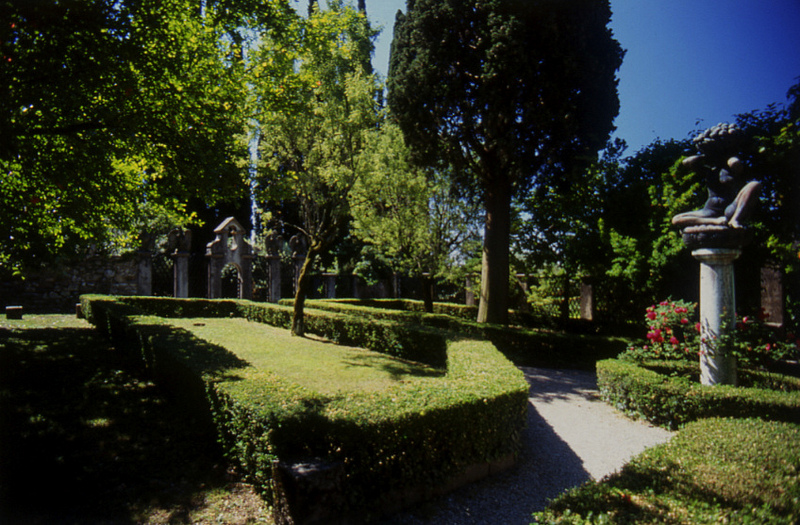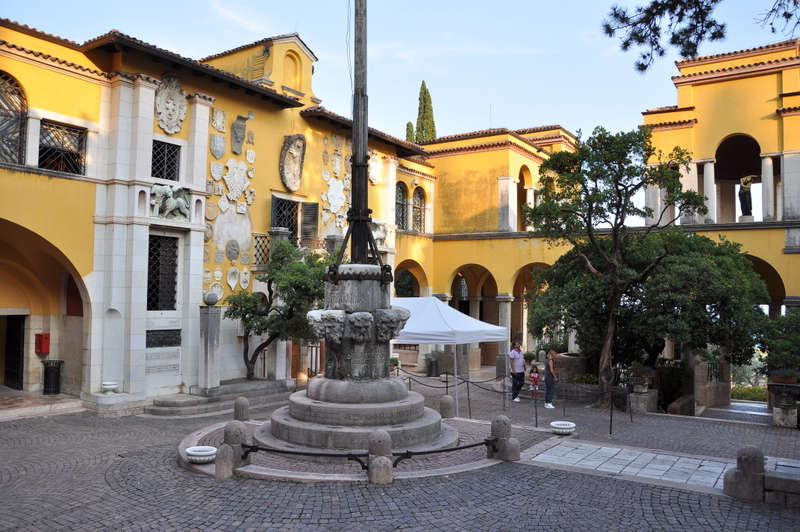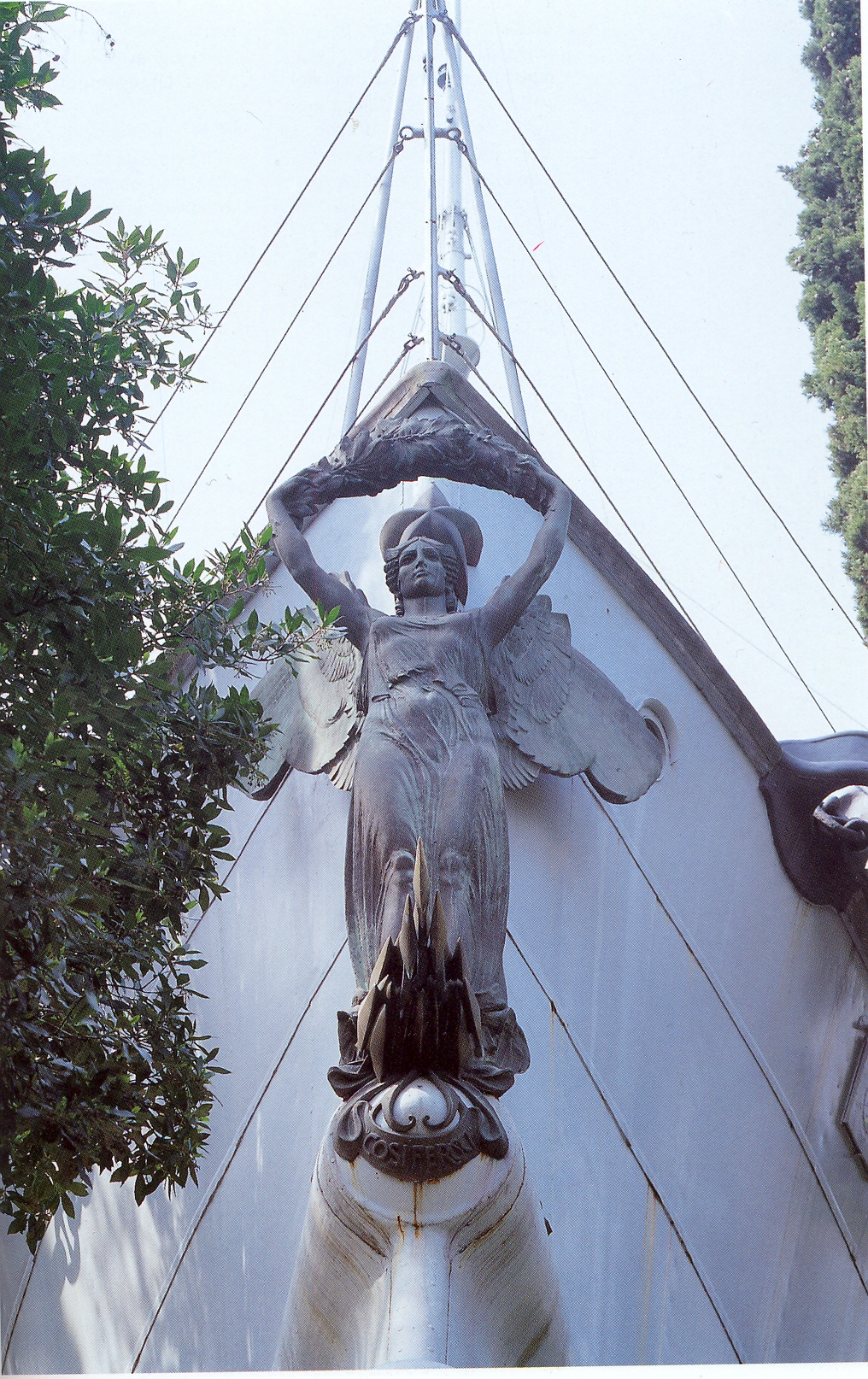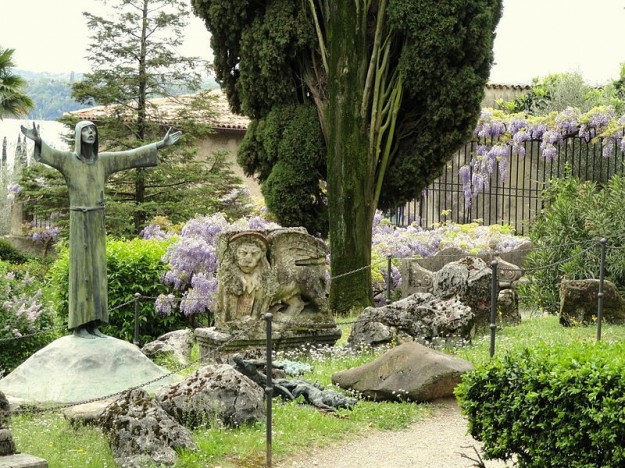
Il Vittoriale degli Italiani
This post is also available in:
 Italiano (Italian)
Italiano (Italian)
Vittoriale degli Italiani is a complex of buildings, streets, squares, an open-air theatre, gardens and streams built between 1921 and 1938 in Gardone Riviera, on the left side of Lake Garda by Gabriele D’Annunzio with the help of the architect Giancarlo Maroni. The whole estate was designed as a testament to the “unique life” of the poet-soldier D’Annunzio and the feats of the Italians during the First World War.
D’Annunzio designed the extravagant scenography in details both for the house, including its peculiar furnishing and thousands of art objects, ceramics, silverware, and carpets and for the 22 green acres sloping towards the lake. The house, which had been previously owned by the art critic Henry Thode, was known as “the Priora” (the prior’s house, according to religious symbolism) and still features several themed rooms divided into the entrance, “stanza del mascheraio” (the waiting room for unwelcome guests), the Room of Music, the Room of the Globe, the “Zambracca” (the bedroom with the poet’s wardrobe), Leda’s room, Apollino’s veranda, the Blue Bathroom, the Room of the Leper, the Corridor of the Via Crucis, the Room of the Relics, the Room of the Lily, the Dalmatian Oratory, the Desk of the Crippled, the Workshop, and Sala dei Cheli (the dining room).
Other buildings are scattered throughout the grandiose estate and have different functions.
THE PARK
The park, built on sloping levels, is made of different areas, each featuring a particular building or site:
the D’Annunzio Eroe museum: created to commemorate the writer’s military past – located in a building called Schifamondo;
an area with boulders fallen from the mountains where great battles took place;
the MAS motorboat shelter: featuring the gunboat used by the poet during the legendary “Beffa di Buccari” (Bakar Raid);
the military ship Puglia: perhaps the most impressive relic, is located under the keep. The ship, on which Tommaso Gulli died in the waters of Split, was donated to D’Annunzio by the Italian Navy in 1923. The bow, symbolically pointing to the Adriatic and Dalmatia, was decorated with a Victory figurehead by Renato Brozzi. In the hull of the ship, there’s a museum – opened in 2002 – which displays some precious vintage models of warships from the collection of Amedeo di Savoia, Duke of Aosta.
From Piazzetta Dalmata, visitors can access the gardens. On the left, there’s the Cortiletto degli Schiavoni, decorated with Venetian puteals. The shape of the courtyard recalls that of D’Annunzio’s birthplace in Pescara. The Portico del Parente, named after Michelangelo Buonarroti, runs around the courtyard.
Once in the gardens, past a stone architrave surmounted by a headless Venus, visitors can admire a grove of magnolias featuring an Arengo in the centre (the Arengo was the place where citizens assembled in medieval Italy). This is the symbolic place where d’Annunzio used to gather his faithful troops from the legendary expedition in Rijeka (Croatia) for commemorations.
On the lower terraces towards the lake, there’s also a lemon grove with the Belvedere and the tomb of Renata – the little mermaid – the daughter of D’Annunzio and the protagonist of his “Notturno” (“Nocturne”, 1916).
Near some cypresses, there’s the dog graveyard, and an orchard with a high column in the centre; on top of it, there’s “Canefora”, a large bronze statue by Napoleone Martinuzzi depicting a squatting woman carrying a basket of fruits. The orchard is surrounded by pillars with large eagles and lilies similar to those that d’Annunzio had, many years before, admired in the gardens of Villa d’Este.
Nature and art coexist among apparitions, symbols, and peculiar sights, enhanced by the presence of Nerium oleander, palm trees, acanthus (
The whole complex, of great visual impact, is surely one of its kind and can be considered an open-air museum. It is located near the lake and, from several areas in the garden, visitors can enjoy breath-taking views of the surroundings.
This post is also available in:
 Italiano (Italian)
Italiano (Italian)
Contatti
Via Vittoriale 12 - Gardone Riviera(BS)
0365 296511
prenotazioni@vittoriale.it
Altre info
8 - 12 euro
Tutto l' anno
orario estivo (dal 1 aprile al 30 settembre) dalle 8.30 alle 19.00 orario invernale (dal 1 ottobre al 31 marzo) dalle 9.00 alle 16.00 Museo D'Annunzio Eroe e Priora chiuso il lunedì





